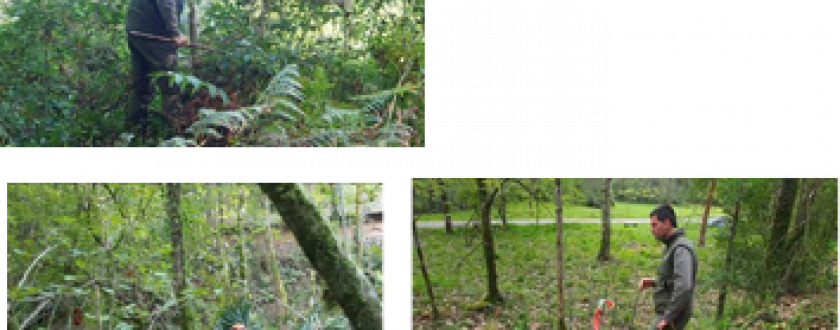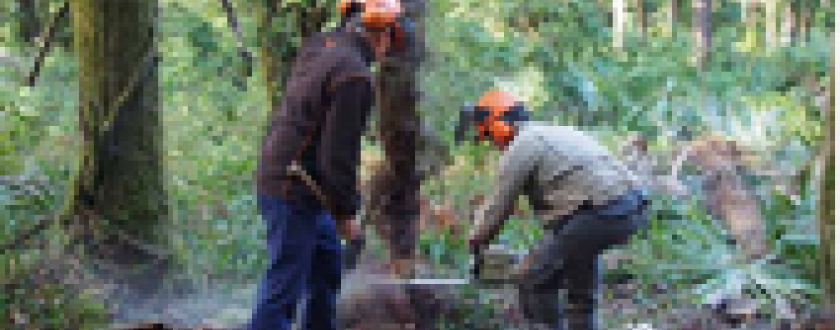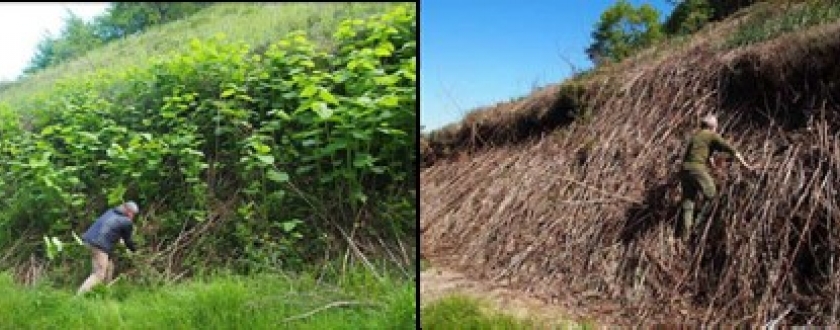Señorío de Bertiz Natural Park invasive exotic plant control and eradication
Description of the case study
Climate change shows a global trend of increasing temperatures, warmer and longer seasons, milder winters, and reduced rainfall. These changes can generate new opportunities for exotic species to expand their current distribution ranges. On the other hand, the probability of any one exotic species finding a more favourable situation for prospering and expanding could increase significantly in ecosystems with a greater number of them. Intervening in these areas that act as focal points for Invasive Alien Species (IAS) dispersion, such as the Special Area of Conservation (SAC) and Señorío de Bertiz Natural Park, is a priority when it comes to limiting their expansion and impact.
In 2008, after the Señorio de Bertiz Natural Park was declared a SAC, its 3rd Uses and Management Master Plan (UMMP) was approved, which includes measures such as the production and execution of an IAS Control Plan, with invasive alien plants being identified as a threat to deciduous forests and native riverbank forests. In 2019, invasive plant control and eradication work started back up with the aim of doing so year after year to be able to see their effectiveness and evaluate the different techniques applied
» Actions to eradicate/control invasive exotic plants. A differentiated treatment is carried out for each species.
» Seeding and planting to promote the uptake of native vegetation and preventing invasive species from re-colonising these areas. Chestnut planting and Quercus robur acorn seeding has taken place.
» Recording all actions and different treatments carried out for the various species and evaluating the results.
» Educating and raising local awareness on the environmental problem caused by the uncontrolled introduction of non-native species.
» Complying with Bertiz’s UMMP operational objective in terms of the increased naturalness of deciduous forests through the progressive substitution of alien species.
» Executing the Control Plan for invasive alien species present in Señorío de Bertiz.
» Continuing on with the Bertiz UMMP evaluation and monitoring programme in terms of “controlling and eradicating alien species” with the specific aims of:
o Controlling the expansion of invasive alien vegetation in the park through a series of concrete, localised, and persistent tasks that allow for efficiency in line with efforts made.
o Carrying out an exhaustive control of the results.
o Educating and raising local awareness on the environmental problem caused by the introduction of non-native species.
Each year the results of actions carried out in years prior are evaluated and recorded. The last assessment was carried out in the spring of 2020:
» A priori, the various treatments carried out to control Prunus laurocerasus, Fallopia, Palmera, Caqui de Virginia, and Pawlonia tomentosa are given positive results, although we will have to wait for evaluations from later years to ensure that it is truly effective.
» The fight against bamboo is abandoned for now as sufficiently positive results have not been obtained, and to focus efforts on more problematic species. Other treatments will be tried.
» Chestnut planting carried out is progressing satisfactorily. Quercus robur seeding was carried out in 2019, so we will have to wait for an assessment of the results.
Case study developed and implemented as a climate change adaptation measure.
Government of Navarre, Navarre Environmental Management, and forest work companies
Additional Information
» 1-2 Environmental Security Guards.
» 1-2 Biodiversity Service Technicians.
» Park management personnel from Navarre Environmental Management (1) and the Government of Navarre (1).
» Forest work companies (3 operators).
» Biology and forest area training.
Limiting factors:
» The necessary investment is high, with significant costs and non-productive tasks.
» Many of these invasive alien plants efficiently resist control tasks: they re-sprout from trunks or roots, spread large quantities of seeds, are capable of taking root from clearance debris, etc. That is why a commitment to continuing on with the started task and evaluating the results is necessary in order to achieve the pre-set objectives.
» The scarcity of studies carried out on target species control and eradication practices, together with the methods applied in other areas not necessarily being efficient or appropriate in new locations and circumstances.
Success factors:
» Minimising the expansion of the current invasive alien species distribution range due to new opportunities arising from the effects of climate change.
Periodic annual investment.
First Year: €16,800; 2nd year: €15,000; 3rd year: €15,000; 4th year yet to be defined.
Self-funding (%): 35.9%
External source: 64.1%, Interreg POCTEFA NaturClima.
The best practice planning instrument corresponding to the 3rd Señorío de Bertiz Natural Park Uses and Management Master Plan (UMMP). In turn, this project falls within Interreg POCTEFA NaturClima.
01/01/2018 - 12/31/2019 (1 year - in progress)
Reference information
PYRENEAN CLIMATE CHANGE OBSERVATORY
Avenida Nuestra Señora de la Victoria, 8
22.700 - Jaca
Huesca - España
+34 974 36 31 00
info_opcc@ctp.org







